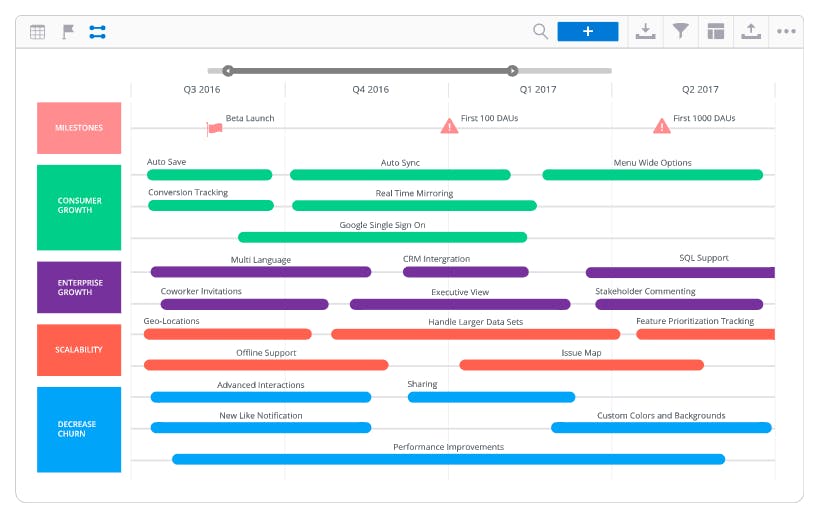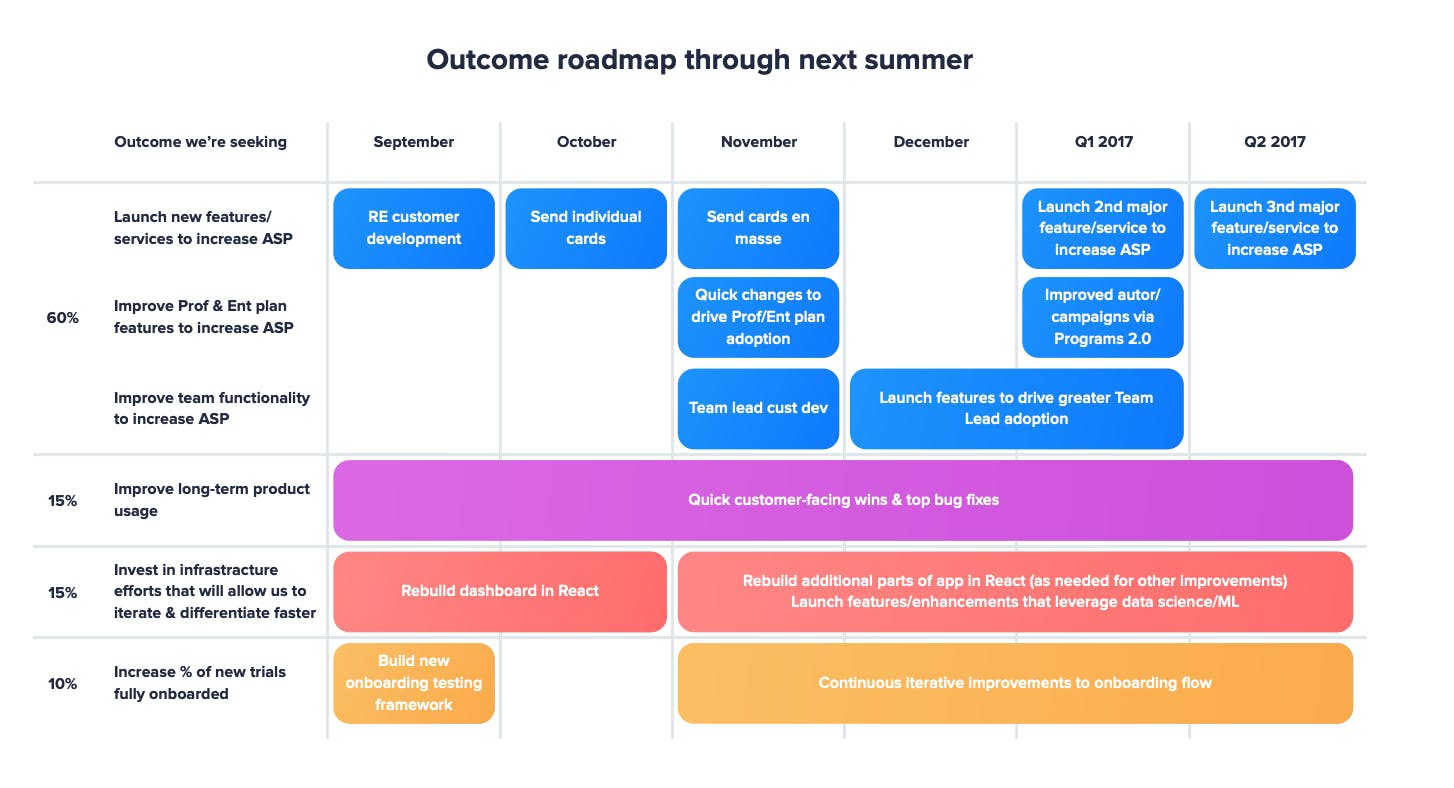Guiding your team through each step of the product development life cycle requires a clear sense of direction, consistent communication, and well-defined objectives. If any of these aspects are lacking, that causes unnecessary confusion and makes it almost impossible to hit your overarching project goals. That’s why, according to a 2019 Gartner survey, “only 11% of organizations reported that all of their products met 100% of defined internal launch targets.”
The right product roadmap helps reduce the potential for confusion. When you define a product roadmap for your team, it acts as a single source of truth of all things related to developing your new product. And the type of product roadmap you choose has a direct impact on how you communicate timelines and strategic vision to your team.
Choosing the right product roadmap sets your team up with a clear path forward, and understanding how all the work they do adds value for customers and your business. But knowing which product roadmap to use isn’t easy — you need to know how each style adds clarity for your team while also making it easier to communicate deadlines and project milestones.
Determine Your Team and Project Needs
Before choosing a product roadmap, you need a concrete understanding of your team’s needs and how those needs inform their ability to work effectively as a group. It takes a lot of hard work and collaboration to complete all the individual tasks that make up the product development life cycle — and your product roadmap is one way you communicate these tasks to the team.
Every project has unique tasks and requirements. Your ability to communicate clear and concise information on why, how, and when your team needs to accomplish these tasks gives direction to the team and makes developing new products as efficient as possible. Each type of product roadmap communicates this information in a slightly different way.
The first step in building out your roadmap is to document all the work your team needs to do throughout a project. Then connect that work to your company goals and overall product development strategy. When you make these connections clear, it helps everyone understand how their tasks push the project forward.
Speak directly with your team after you’ve documented this information — they will help narrow down which product roadmap communicates your strategic vision and work requirements best. When you share this information, it increases visibility into potential bottlenecks and scheduling conflicts, so you can address them before they cause issues for your team.
You can also combine different types of roadmaps based on what kind of information you need to communicate. Use quarterly roadmaps to talk through high-level company objectives and connect those roadmaps to form a three- to five-year plan. Then break up your quarterly goals into monthly or weekly projects — this helps you easily track your work on a project-by-project basis as well as a long-term view.
Both high-level project timelines and day-to-day tasks will help you lead the team through critical touchpoints along the product journey. When you analyze each roadmap’s effectiveness at the end of a project or quarter, it helps you identify areas of improvement and attack the next project with more clarity. As your team evolves, you’ll narrow down which types of product roadmaps work best for every situation.
5 Types of Product Roadmaps
Roadmaps come in many different shapes and sizes depending on your team’s requirements, the tools you use, and overall company goals. Determining which type of product roadmap to use requires understanding how each one helps your team track milestones and deadlines throughout a product’s life cycle.
Your product development process also guides the type of product roadmap you’ll choose — each roadmap has value for a different situation.
1. Use Feature-Driven Product Roadmaps to Highlight Product Value
A feature-driven product roadmap helps you track progress for your project throughout the product development process. It shows your team how each feature they build connects with others and helps map out how your product evolves over time.

Feature Roadmap via Roadmunk
These roadmaps are good at helping you focus on how different feature components, such as Auto Save or Offline Support, build on each other to add value for users. The example above organizes these components based on their impact on your customer or business: green for consumer growth, purple for enterprise growth, red for scalability, and blue for decreasing churn.
Each feature is color-coded to help your team differentiate one initiative from another, which makes identifying potential bottlenecks across projects easier. You can scope out how long it takes to build the feature — like Performance improvements — and see that it takes almost the entire development cycle to complete. That means it is more complicated to work through and has more potential points of failure along the way.
A feature-driven product roadmap also helps you nail down resource allocation across different projects happening at the same time. Everyone involved in the project will quickly see why one team needs more time to complete their tasks and how their work contributes to the project’s success as a whole. This visibility makes communication with key stakeholders throughout your team much less complicated.
2. Use Theme-Based Product Roadmaps to Stay Connected With Your Strategy
Theme-based product roadmaps take a step back from feature-driven roadmaps and help you organize your project and development work around high-level strategic objectives. Thinking about your work as part of larger themes helps keep the team connected with overarching product and business goals while also helping them structure their work more effectively.

Theme-based roadmap example via ProductPlan
Theme-based product roadmaps help you think about your team’s work in a more user-centric way, as it follows the same principles of user-story mapping. Each theme gets broken down into epics, then stories, which helps you create a narrative structure around how individual work adds value to the product with each release.
When you focus on the structural aspects of a project in this way, it helps your team conceptualize their work’s impact on both your business and the user. And that clarity helps the team make better overall strategic decisions for the direction of the product.
Connecting these user stories back to epics and high-level themes makes it easy to track how day-to-day work adds value for users. This knowledge means you don’t have to spend as much time justifying your work and can easily showcase the effect your team’s hard work and resources have on the company’s bottom line.
3. Use Outcome-Driven Product Roadmaps to Tell a Story About Users
Outcome-driven roadmaps look at project-based work through the lens of how each release helps users accomplish a specific goal or task. They provide context for your team and connect the day-to-day project work to a particular outcome.

Outcome-driven product roadmap via Productboard
Outcome-oriented product roadmaps change how your team thinks about their work. They’ll understand how it adds value to the product experience and how it helps your target audience accomplish their individual goals.
When you think about the product experience in this way, it makes coming up with new ideas, refining those ideas, and prioritizing your work simple. You’ll know precisely what adds the most value today as opposed to what can wait until later in the product development process.
It’s also easy to connect outcomes to specific product metrics and key performance indicators (KPIs). Let’s say you’ve identified an issue in new user onboarding related to adding duplicate information to customer accounts. Releasing a feature that pulls previously entered information from other areas of the account and auto-populates new pages would solve that problem for your users. Outcomes-based product roadmaps help you connect that solution to engagement rates, customer ticket volume, and overall satisfaction to determine your release’s overall effectiveness.
4. Use Now-Next-Later Product Roadmaps to Communicate Clearly
These product roadmaps communicate high-level deadlines using a simple prioritization framework: now, next, and later. Thinking about project work in this way helps your team understand the strategic priority of different product work without tying that work to specific deadlines.

Now-Next-Later product roadmap example via Productboard.
These simple product roadmaps are great for fast-moving companies that are still actively learning about their market and audience. If you lack a clear sense of how your work impacts the customer due to insufficient knowledge of their needs, these Now-Next-Later roadmaps help you pivot quickly without losing momentum.
When you use this type of roadmap, you need to define exactly what each term means. While the name is simple, explaining what a Now-Next-Later roadmap means ensures that everyone involved in your project is working on the same timetable, and solidifies engineer prioritization. Everyone needs to know how their schedules fit into these buckets to prioritize their work effectively.
Now-Next-Later roadmaps are also really useful for communicating complex project work to non-technical audiences. Let’s say you have stakeholders throughout the organization who are removed from the day-to-day work that goes into product development. These types of product roadmaps help you communicate the work your team does in clear and straightforward terms.
5. Use Agile Product Roadmaps to Break Up Complex Work
Agile product roadmaps are built around the Agile product development process. It breaks up project work into easy-to-understand work units called sprints and plots out how long those sprints will take to complete. It’s an excellent roadmap for teams with an existing Agile process in place and an understanding of how sprints work.

Agile product roadmap via Asana
Agile product roadmaps incorporate the best aspects of feature-based and Now-Next-Later roadmaps. They help your team structure high-level quarterly timelines with the daily sprint work. Following Agile guidelines also makes it easier to iterate and pivot to new work with each sprint. For example, the Asana board above labels these sprints within the context of a larger calendar, which connects bi-weekly sprints to quarterly and yearly objectives based on their overall difficulty.
The Agile method takes a more holistic approach to product management and gives your team the tools they need to break down big projects into manageable work units. That process forces you to think about prioritization on both the micro and macro scale.
Agile product roadmaps work best when used in tandem with technology like Asana, Trello, and Atlassian. You need a way to visualize all the different tasks and processes that occur throughout development.
Product Roadmaps Make Executing On Complex Work Simple
A well-defined product roadmap ensures that each team member can work through their individual project commitments in complete visibility of the team. Increased visibility not only makes identifying potential bottlenecks easier, it also gives everyone the autonomy they need to work through tasks quickly. When your team can collaborate efficiently, you give them the tools they need to deliver high-quality work faster without sacrificing quality.
